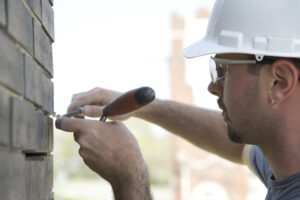 Durable repointing mortar must be the proper strength, permeability, color, as well as free of shrinking and gaps in order to be considered high quality and built to last. Over the years we have seen good repointing jobs and rather questionable repointing jobs.
Durable repointing mortar must be the proper strength, permeability, color, as well as free of shrinking and gaps in order to be considered high quality and built to last. Over the years we have seen good repointing jobs and rather questionable repointing jobs.
You want the best for your structure in order to ensure its longevity, which means you need to know these 8 key factors when it comes to producing a durable repointing mortar that will get the job done without fail. The mason you choose to repoint your structure must know these requirements or else your wall, home, building or walkway is in serious danger.
Stronger Mortar Doesn’t Mean Better Mortar
We live in a society that sees ‘strong’ as a positive quality, therefore wouldn’t that mean stronger mortar is always better? Wrong. When it comes to repointing masonry the answer is a definite no, stronger does not equal better. In fact, if you go with mortar that is too strong you will actually destroy the structure as opposed to restoring it.
Mortar should never be stronger than it needs to be. Overtime the compressive strength should be less than the masonry; otherwise it creates so much pressure on the bricks that they begin to weaken and crack. Your mortar is much cheaper to fix than your entire masonry structure, which is why it’s so important to make sure you hire someone that knows what they are doing when it comes to mixing and applying mortar.
New Mortar Needs To Be More Permeable Than Old Mortar
You want the new mortar to be more permeable than the mortar currently being removed. The restorative mix should contain only the required dose of Portland cement in order for drying out to occur through the bed joint instead of through the masonry unit. The reasoning behind this is so that during a freeze thaw cycle moisture will go inside of the mortar pores, preventing it from soaking into the brick or stone. This also allows the release of harmful salts through the permeable joint bed.
No Gaps Between New Masonry And Unit
If you see gaps in between the masonry unit and the motor there are big issues on the horizon. You never want to see any gaps at all in between the new mortar and the original unit. If there are any gaps water has a free entry point to get inside, pooling up in large quantities and causing damage pretty quickly.
No Shrink Repointing Mortar
The repointing mortar used should incur as little shrinkage as possible. One way to reduce the presence of shrinkage is to use washed sand with a good variety of small, medium and large particles. No “Fine” small clay should be present either.
Same Color + Texture
Repointing mortar involves removing portions of mortar and replacing it with new mortar. Therefore, the original mortar still exists alongside the new mortar. You want these two mortars to match in order to create a cohesive appearance. This is why it’s important to create a repointing mortar that matches the original as closely as possible in every way including color and texture. A professional mason will be able to conduct a simple test to determine the appropriate mixture in order to accomplish a cohesive look.
Mortar Resistant To Freeze Thaw Cycles Is A Must
Living in Toronto you can expect severe freeze thaw cycles are going to occur. What you need is mortar capable of resisting the negative impacts of this natural occurrence as best as possible. In order to accomplish this, 8-15% of the mortar mix should be air. The air must be entrained on purpose so that it can accommodate freezing moisture without incurring damage. An example is SA hydrated lime that has air entrainment and appropriate sand specifications mentioned in number 4.
Technique Is King
Mortars made with quality technique make a big difference. Mortars must be properly matched and mixed to the restoration job at hand. A skilled mason will know the how to make a wall stronger using proper repointing techniques.
Historic Mortars Require Extra Special Attention
If you are repointing an historic building everything changes. As always, the mortar should be made to match the original, but this is complicated a bit when dealing with buildings constructed with old-fashioned techniques. It’s important to use these ‘outdated’ processes to create a proper replication of original mortar.
By using new construction techniques and modern Portland cement you are going to cause more damage than good. Portland cement becomes increasingly harder over time, eventually becoming denser than the surrounding bricks and as a result the entire structure is under too much pressure and in danger of complete collapse. Lime mortars should be used on historical restorations, just as they were in the original construction, thus allowing the building to age naturally as it should.
You can count on Turnbull Masonry to create the highest quality repointing mortars for new and old construction. Contact us today to learn more and get a price quote for your project.
